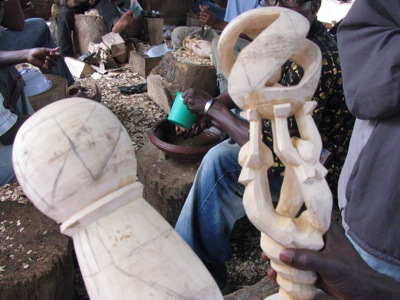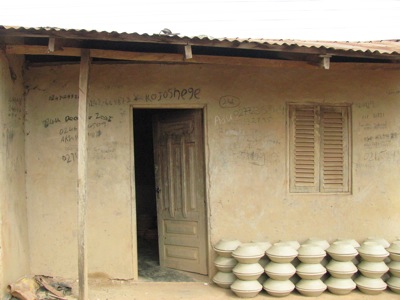Ghana One: Who’s Who?
With the final week upon us I thought I’d introduce you to my teammates from the inaugural IBM Corporate Service Corps mission in Ghana. (Update: I added myself.)

Ritu Bedi
Alias: Sweet Mango
Home: Delhi, India
Primary Skill: Breakfast negotiation.
Little-known fact: Acid reflux almost caused Ritu to bail out of the Kakum Canopy Walk.
More on Ritu’s assignment.

Arindam Bhattacharyya
Alias: Hookah
Home: Kolkata, India
Primary Skill: Has a sixth sense for locating good Indian food anywhere on the planet.
Little-known fact: Arindam can eat more than you. Try him.
More on Arindam’s assignment.

Roslyn Docktor
Alias: Happy Camper
Home: Washington, DC, USA
Primary Skill: Clipper-based hairdressing.
Little-known fact: She’s been to Zambia. No really, just ask her!
More on Roslyn’s assignment.

Pietro Leo
Alias: Tee Wee
Home: Bari, Italy
Primary Skill: Injecting humor when it is least expected or appropriate.
Little-known fact: Looks equally crazy when clean-shaven.
More on Pietro’s assignment.

Julie Lockwood
Alias: Gertie
Home: Boulder, CO, USA
Primary Skill: Can frighten small Ghanaian children to tears simply by looking at them.
Little-known fact: Has visited 90% of the toilets and “near-toilet experiences” in Ghana.
More on Julie’s assignment.

Fred Logan
Alias: Chief
Home: Ottawa, Canada
Primary Skill: Capital infusion to the local souvenir and handicraft industries.
Little-known fact: Taught disco dancing in the 1970’s — even appeared on TV.
More on Fred’s assignment.
Stefan Radtke
Alias: Shortwave
Home: Bonn, Germany
Primary Skill: Can speak in morse code.
Little-known fact: Set up a full shortwave radio station at our hotel.
More on Stefan’s assignment.

John Tolva
Alias: Mule
Home: Chicago, IL, USA
Primary Skill: Perspires more than his body weight every four hours.
Little-known fact: With enough tin foil, Stefan’s shortwave antenna, and an intricate yoga pose John can steal wireless from the hotel down the street.
More on John’s assignment.

Charlie Ung
Alias: Flip-Flop
Home: Vancouver, Canada
Primary Skill: Imperturbable.
Little-known fact: To mosquitos Charlie is mostly a bony frame transporting a big bag of delicious blood.
More on Charlie’s assignment.

Peter Ward
Alias: Biscuit
Home: Warwick, England
Primary Skill: Extraordinarily detailed blogging.
Little-known fact: Peter has wireless access in his room and, as such, is the object of a team conspiracy to abduct and relocate him.
More on Peter’s assignment.
Textile
Part four of the Ghanaian Handicraft series.
Few crafts are as closely linked with their place of production than kente cloth weaving is with Ghana. Tradition holds that five villages in the Ashanti region were declared official kente-weaving centers by the first king of Kumasi. Only two of these villages still produce the textile and of these Bonwire (pronounced bon-RAY) is the most famous.
The colored yarn is imported — a rare example of an international supply dependency in Ghanaian handicraft. This may be more a sign of market demand for the widest range of color and, as such, would be a positive thing, evidence of adaptability in an ancient form.

Before being placed on the loom, individually-colored yarn strands are reeded and warped in open outdoor spaces. This basically consists of mixing the colors together manually (by drawing out precise lengths then painstakingly intertwining separate colors) so that the weavers have the color elements pre-assembled when they insert it into the loom. It’s warp and weft sous-cheffing.

Though mass-produced kente can be churned out from automated looms, the traditional setup is a wooden box that fully engages the limbs of the operator. Feet press on make-shift pedals to raise and lower the separate planes of fabric (which form the kente background) while one hand flits the bobbin of thread in and out (which creates the actual design). The other hand variously adjusts the comb that pounds the new threads into place and a separator that gives the bobbin more room to work. It happens fast.
It’s mesmerizing really, high-technique, high-speed, and in full color. (There’s high tech too. New designs and particularly complex patterns are designed first using a custom computer application. There’s no automation involved, just a pre-design that when printed helps the weavers understand the sequence of overlapping shapes needed to make the end design.)

Men — and it is always men, traditionally — work at the looms side-by-side. There’s no talking, no singing, maybe a radio on, but basically just the hypnotic squeak and wooden clatter of the looms.

Typically a single 8″ by 5′ section of kente takes a month or more to finish. Sections are sewn together and sold in larger pieces as traditional Ashanti tunics or for Western uses such as duvets and throws.

To come across a workshop in Bonwire is to enter a world of bold geometries and colors — a vibrant contrast to the matte earth tones of what is otherwise a fairly poor village.
There’s a cultural center outside of Bonwire that’s totally deserted. (It has a relatively clean toilet; we’ve stopped there twice.) Clearly this was the town’s attempt at capitalizing on its famed craftsmanship — but that plan seems to have run off the rails. If any craft village can become a tourist destination it is Bonwire. Our goal, in part, is to help Aid to Artisans figure out how to do this.
More textile-weaving video here.
A homecoming
Our great family friend Margaret Kumi has arrived in Kumasi from Chicago. I could not be happier (unless it were my own family who arrived). She’s brought a care package from home and familiarity — maybe the best package of all.
Sunday she and I head to the village of Tanoboase to meet the chief and see what can be done. (Backstory here.)
Abena Dekyi, Margaret’s sister-in-law, prepares homemade dishes for us in her home. Hands down the best meal I have had in three weeks. Yum!
Glass
Part three of the Ghanaian Handicraft series.
Glass beads are not an indigenous art form in West Africa. Today’s Ghanaian bead-makers continue a craft introduced by Europeans in the 15th century. Glass beads, made then primarily in Venice, were used as barter for the raw materials that Europeans desired. As glassmaking was not widespread in Africa the articles of fashion made from the beads were highly sought after and, in time, came to be called ‘trade beads,’ a de facto coin of the realm.

Trade beads were often swapped for slaves. You’ll also hear them referred to as ‘slave beads.’ Unlike some Westerners, contemporary artisans obviously find no dark irony in carrying on a craft meant initially to quantify the worth of a human being. And why should they? Like refusing to salt your fries because it too was once used to barter for slaves.

The “raw” materials for the bead-makers are discarded bottles. It’s a wonderful thing, really. At zero cost, the artisans collect up as much glass as they can (though, admittedly it is a bit tougher here than in the West because you can’t buy new bottles of soda, for instance, without returning an empty one). From trash to jewelry — can’t beat that product life-cycle.
The bottles are smashed. And smashed again. And again. Repeatedly until the glass is just a fine, pulverized powder. (Don’t inhale.)

Once in powder form the glass is mixed with various dyes and filled into molds depending on the desired bead shape. Then, into hell’s oven for melting.

Typically the molds yield semi-circular halves which are then melted together to form spheres. They are then joined on a string, often with differently-colored beads, thanks to the central axle in the mold that preserves a hole through the bead.

More bead-making video here.
Straw
Part two of the Ghanaian Handicraft series.
Straw weaving is not a craft normally associated with the environs of Kumasi. Mostly that honor belongs to the far northern town of Bolgatanga. (Say that word. Say it now. And enjoy how delightful it is to hear.) But we wanted to get a sense of the craft and it turns out that the actual raw material (the straw) is cheaper nearer to Kumasi. So some small artisans have sprung up.

It’s the simplest craft we’ve observed. The most serene too. A single artisan with a bunch of straw strands, some dyed, sets out and weaves the object in mind. No tools; the very definition of handicraft and skill.
It’s a family affair in the small villages that produce straw-woven goods. Everyone seemed so damn happy, just weaving away. They know what they are doing, how to do it, and why they’re doing it. It was inspirational, in a way.

More straw-weaving video here.
Wood
Part one of the Ghanaian Handicraft series.
Wood-carving is one of the oldest craft traditions in Ghana. Wooden sculpture is produced throughout the country and has a high export value. Two weeks ago we visited the village of Ahwiaa to observe and talk to artisans trained in the traditional discipline.
Wood is delivered to them from the forests hewn roughly into the intended shape of the end product. From there small outdoor workshops of carvers set about shaping the objects into final form. The workshops are a welter of flying wood chips, sweat, and clanking. Masters silently instruct their apprentices.

It all seems so random and haphazard, but obviously these gentlemen know what they are doing. And they are all gentlemen. Female woodworking is taboo mostly because of the posture assumed by artisans: the wood chunk is held between the legs and shaped there. Ghanaians disapprove of tools being used in the vicinity of female genitals.

The artisans are preternaturally fit. They look carved from solid material too. The main implement is a metal gouge placed carefully on the wood and then struck by a mallet. The carvers wear two pairs of pants over one another for protection. The outer pants are ripped and frayed from numerous skewed strikes.
We visited the main woodworking area in Ghana, an area of the Ashanti region near Kumasi. Traditionally the king of the Ashanti (called the Asantahene, currently Otumfuo Nana Osei Tutu II) is the custodian of all arts in the region because of the historic relationship between craftsmanship and the royal house. What this means today is that he serves a quasi-governmental position of promotion and support for the arts, including being the nominal patron of our organization Aid to Artisans.

Aid to Artisans does more than just serve as a middleman for the producers. They hold courses on reforestation and forest management for their producers and recently purchased a small section of woodland as a kind of nursery/laboratory for the study of sustainability techniques.
And yet, it seems to be a losing battle. Every day I’ve seen huge trucks hauling massive felled trees. In fact they aren’t really trucks, just two sets of wheels lashed to the mammoth trunks. Even in Kakum, which is protected by law, there is logging taking place. One wonders how much longer this art form can survive without importing lumber.

More wood-carving video here.
Social bookmarking in Africa
Geeks in the West are infatuated with social media. And for good reason, sharing makes good, selfish sense. It allows processing the infoglut through the filter of people you know and trust. And yet, as in so many things that computers make easy, social sharing of data requires nothing more than a communication medium and a community.
Two weeks ago we visited Mfensi, a village outside of Kumasi graced with a clay-banked river. It is, thus, a pottery-making center. I’ll post about the fascinating process from river-bottom to pottery in a bit, but for now have a look at this. It isn’t graffiti, but rather the village phone book.
The mobile phone is king in Africa, of course, but there are no add-on services as in the West. No voicemail, no server-side contact list. You can call and text and that’s about it. So why not have a community address book? Scrawl it on the wall. No downtime — and if you need context you just ask someone. Simple and wonderfully efficient.
What I’m doing in Africa
I think some of you are wondering what I’m doing here in Africa besides site-seeing and longing for faster connectivity. It’s an odd thing, for sure.
There’s only one flight from the US to Accra, Ghana and I was on it. Looking around the cabin you see mostly Ghanaians and the white people you just wonder about. At the risk of grossly generalizing, I’d say business class is full of well-heeled business people and perhaps aid workers with enough frequent flyer miles to qualify. It’s a distinction I’ve been pondering since I arrived. Which am I?
The IBM Corporate Service Corps, of which I am a part, is a bit of both. Our goals are equal measures corporate social responsibility for a global enterprise and advance market research in a promising country. There are 10 of us here — and teams elsewhere around the world — who are helping small businesses pro bono both because it is the right thing to do and because it provides us with knowledge about how best IBM could become part of the marketplace here.
Each team has multiple projects. Mine is with a group called Aid to Artisans, the primary NGO tasked with promoting, educating, and marketing traditional Ghanaian handicraft locally and worldwide.

Here are our specific objectives.
- Assist ATAG to construct an interactive website to serve as an informational tool, showcasing the activities and operations of the organization to the outside world. The site should help the organisation to create more avenues for market development through e-commerce and to enable ATAG to communicate and link-up with members of its affiliate association (ACNAG) in a more free and convenient manner.
- Conduct a supply chain analysis serving to bridge the gap between the concept stage of product development to the production stage through to the end user of the product in question. The analysis will include sourcing raw materials, designing, prototyping, production of products to packaging, warehousing, exporting and retailing through to the consumer.
- Capture the relationship between the processes and document them, if possible, audio-visually.
It’s a strange middle ground we occupy. Not exactly business, not exactly aid. (Indeed, some NGO folks we’ve met expressed outright skepticism at our mission here. While, back home, most businesspeople take a while to understand why we’d ever go to Ghana.)
My sub-team colleagues are the talented Julie Lockwood and Charlie Ung.
When we’re not traveling to meet the producers in the villages or the exporters at the coast we work at the Aid to Artisans field office in Kumasi. It’s a great space at the Cultural Center. Can’t beat the ambient music.
In the queue is a series of posts on each of the different types of artisans we’ve visited. That’s the good stuff. Soon.
The integral trees
I’ve heard Ghana called “Africa for Beginners” mainly because it is relatively stable, economically promising, and English-speaking. Yet it is also not the Africa of Western, romantic stereotype. There’s no Heart of Darkness-esque jungle, no Lion King savanna. Ghana once was mostly rainforest, but logging and farmland creation mostly denuded the landscape in the last century.
Still there are patches, now protected. One of the best is Kakum National Park, just outside of Cape Coast a few dozen clicks from the beach. We visited Kakum on Saturday. It was breathtaking. Sublime in the true sense of the word: beautiful and terrifying.

Apart from the wildlife — which includes such rarities as pygmy forest elephants (I had no idea such a thing existed) and a crazy diversity of birds — the park’s main attraction is an elevated rope bridge walkway right through the tree canopy. It’s an amazing thing. You set out on it just a few meters above the ground and are several hundred feet above the forest floor before you realize you can’t turn back.
It’s all rope and wood plank and with the exception of the rusting steel wire brings immediately to mind the scene from Indiana Jones and the Temple of Doom where our hero hacks the bridge in two.

There are seven bridges in all, stretching more than 1000 feet between gigantic trees on which small viewing/rest platforms have been constructed.
It was all built in 1995 by shooting rope via crossbow from tree to tree, then scaling the monsters old school, ground-up style and rigging the rest. You don’t question the engineering as much as the 13 years of maintenance. Things deteriorate quickly in a rainforest. Also, big as the trees are, once you land on the platforms there’s a noticeable sway — emphatically not the thing you want to feel having just crossed the chasm. It’s scarier than it seems.
There isn’t a whole lot of wildlife-viewing up on the bridges. Mostly you’re battling the sweat that threatens to compromise your grip on the rope “rails” and hoping no one on your stretch panics.
An economy of enslavement
Last year I had the privilege of building the initial website for the National Museum of African American History and Culture, the newest Smithsonian institution on the Mall in DC. It was a period of deep immersion for me in facets of my national history that I had only a survey-level understanding of. I was very much looking forward to visiting the slave castles of Ghana’s coast.
This past weekend we visited Elmina and Cape Coast, the largest transfer points for the Middle Passage of slaves to the Americas by European traders. Both towns feature beautiful white-washed castles that sit atop dungeons of horrific ambience and memory. They held about 2,000 male and female slaves at a time before transfer through “doors of no return” to awaiting ships.
I’ve been in Africa for over two weeks and not once felt self-conscious about my skin color. But inside these castles I couldn’t help but feel like an interloper. No one made me feel this way, to be sure. And I felt no personal guilt: my family came to the US well after the slave trade was abolished. And yet, touring the castle with two African-American couples felt slightly strange, like I was intruding on something sacred. The slave dungeons were full of flowers left by descendants.
At dinner that night I told Asha that slavery is a source of shame for America (though, I suppose, in truth I was speaking for myself). She added that it is a source of shame for Ghana too. The peoples of Ghana are as implicated in the trade as Europeans of course. White traders didn’t raid the interior of Africa for slaves; captives were traded from rival tribes for weapons, gunpowder, and alcohol. Of all the parties involved in this foul enterprise, only the slaves escape blame.
You pass through the Door of No Return in Cape Coast Castle and you’re back in the present. Fishermen mend nets in the shadow of the fort, carrying on the work that existed before the Europeans came. Children look out to sea and frolic in the waves. The past is just a big white building.























